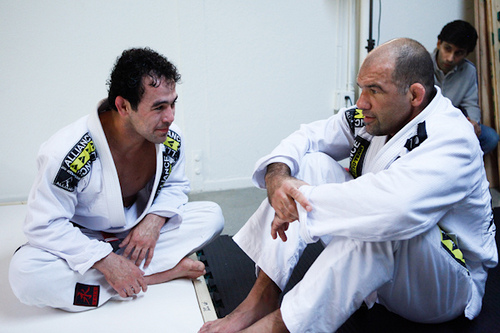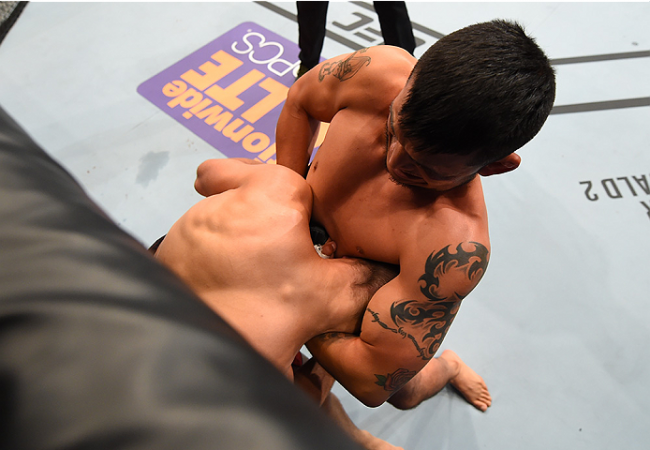
A black-belt since she was 20, with world titles at every belt, the half-Brazilian, half-American Mackenzie Dern (Gracie Humaitá) collects victories in all arenas: No-Gi Worlds, ADCC, Pan, European Championship and her MMA debut. And all of it while playing good-looking, aggressive BJJ which often draws applause from the crowds.
With grace and bravery to spare, Mackenzie, the No. 1-ranked black-belt in 2015 and 2016, was born in Phoenix, Arizona, and has been playing in the dojo since she was three with dad Wellington Megaton, and competing among adults from age 14. Unafraid of getting squeezed, Kenzie has always enjoyed training with her dad and with the guys. Mackenzie Dern believes in hard work and sees tournaments as the fun part of BJJ.
Graciemag attempts to show, here on our website as well as in our magazine, the intimacy of champions, and also bring the reader into the conversation, in an endeavor to offer more motivation and knowledge to you, your students and your family. This article was originally published in our magazine. Subscribe to Graciemag and secure access to the best coverage of worldwide BJJ. Below, check out some of the main lessons from this lovely badass who drew inspiration from the feats of Kyra Gracie.
GRACIEMAG: How do you try to make your BJJ more offensive? Do you do training focused only on submissions?
MACKENZIE DERN: No, I don’t do any specific training to sharpen my finishes — it’s just my way of attacking. I always feel better in a fight when I’m one step ahead of my opponent, and that’s what I try to practice every day. What I do is try not to accept positions, despite how hard my training partner might work to make me. What I do, many times, is choose an objective for the day’s session and focus only on that. For example: one day I choose to only pass guard; on another I spend the session just honing sweeps. This, I feel, helps me a lot to make me feel comfortable in any situation. Once they’re comfortable with all aspects, the athlete is naturally closer to adjusting themselves, they can control their opponent better, and the submission arises more easily, in whatever position.
How do you interpret the current women’s BJJ scene?
I’m very satisfied to see more and more women at the World Championships, and the categories getting fuller — that already makes a big difference to the athletes and the audience. Besides, that forces us to fight more matches, and so we’re forced to take on a greater variety of styles. That is, we are evolving personally, and women’s BJJ is evolving alongside us. It’s very good to see women’s BJJ grow.
What advice can you offer to girls who are still hesitant to put on the gi?
My tip is to start out trying a few classes with girlfriends. Invite a good friend of yours and try out a class. It gets even more fun. BJJ is a lifestyle that helps with health, self-defense and self-esteem; that way, starting to practice with friends, beginners will have more reasons to stay motivated, especially on those days where we think of giving up, which happens normally. My advice is to call your girlfriends and help one another, striving to grow together in class.
What did you, a featherweight, learn as you fought heavyweight Gabi Garcia several times?
Every time I fought her, at the 2015 European, the Pan and the Abu Dhabi World Pro the same year, I learned that you cannot afford to err by even one millimeter. It’s hard to train to fight her, because you can’t get a training partner with the same game as hers. In each fight I felt like I was in a test. It was a test to learn what was going to work that time, and whether anything would work, you know? I would try several guard resources to see what worked and what did not, due to the weight difference. It really isn’t easy spending nearly half the matched folded in half.

Gabi vs. Mackenzie
You’ve been training for almost 20 years, and you have learned both old-school training habits from your father Megaton, who was a strong judoka to boot, and aspects of modern training. How did you mix it all up to create your game?
I’ve learned a lot from my father, and nowadays I learn a lot from elite competitors. I’ve learned a lot about different training methods and what is really needed in order to conquer what we dream of. I learned that each person has a different way of training or executing the techniques, but there is one point in common: every champion dedicates themselves a lot, to the point of pushing their limits every day they train, and always going a little further. Striving to exceed oneself is the secret. And I think that has helped me a good deal. I think I’m lucky to know so many good people and get a little bit from each of their training methods. Preparation is the main thing; I think fight time should be the easier moment compared to all the preparation to get there.
Whom did you look up to when you started out?
Kyra! I’ve always been a big fan of hers and wanted to get where she was. But I don’t feel like I tried to copy anybody’s game specifically. I’ve always admired many fighters, male and female, and what I sought was to take a bit from each. I think we always get inspired and try to copy a bit from BJJ that is pretty and winning. For example, I’ve always enjoyed watching Marcelo Garcia’s BJJ fights, as well as Leo Vieira’s and Ronaldo Jacaré’s.
Do you think about becoming a mom one day?
Yes, I want to be a mother someday! I have some goals to achieve first, both in BJJ and MMA in the near future, but I already think of it. I want to fight more MMA first. But I would certainly like to pass along to my kids some of what I did and learned.
How do you train to correct your mistakes?
I spend many hours on my shortcomings. I’m always seeing what I did wrong in the videos, even in fights I won. I’m always trying to improve my game and expose myself less, because there’s never a perfect performance. The secret is to perceive that there’s always a detail and to improve, and thus I’m always striving to reduce my weak points. If there’s a position where I feel I can improve, where I’m not 100% comfortable, I put myself in it during several training sessions until I think I have improved. Sometimes I’ll spend the entire session just training one aspect of one guard pass, or just practicing one type of guard, for hours and hours. And I also try to train my mind a lot — that is, visualizing my next objectives and working my confidence on how to execute that when the time comes.



